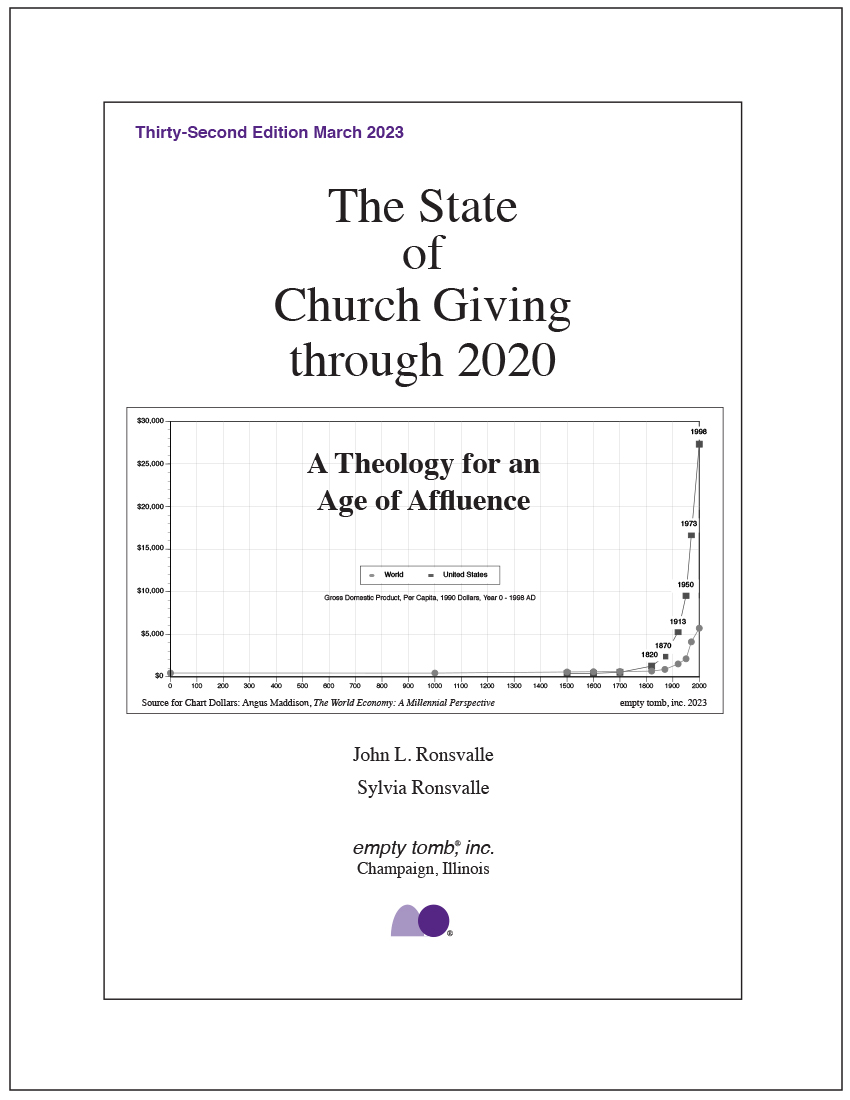“The critical question before the church might well be stated: Do Christians want to accept the death of the institutional church in the U.S., or get to work?” That is a quote from the recently released report from empty tomb, inc.’s thirty-second edition of “The State of Church Giving through 2020.” What caused them to write that? This fact:
In 2020, 1.83% was the amount Americans gave out of their disposable personal income to churches. That is the findings of empty tomb’s yearly report, which is the most detailed analysis of the state of giving there is. It is so detailed that it takes two to three years to file, which is why this current report, released in the spring of 2023, goes through 2020. What makes this study unique is its focus on the percentage of giving, not the total amount given.
I’m going to break that down for you in this edition of the Coach entitled The 2023 Coach’s Annual Review of “The State of Church Giving.”
Here is a list of what I think are some of the most important statistics…
- From 1968, when they began their study, to 2020, per member giving to total contributions increased 71% in inflation-adjusted dollars.
- However, after taxes, Disposable Personal Income (DPI) for the same period increased 182%. Members are making more and giving less!
- Giving as a portion of income declined in all categories, reaching the lowest point in giving since 1968 when the percentage stood at 3.02%.
- If the same portion of income had been donated in 2020 as had been donated in 1968, the Church would have had $13.9 billion more dollars to use.
- The decline in giving is directly proportionate to the decline in church attendance. Whether online or in person, we are engaging with fewer Americans than ever.
This is the other side of the giving coin that few notice or pay attention to. We would do well to pay attention. Here are some of my thoughts…
Our focus is on the wrong side of the coin. “Our giving is actually up.” I hear that continually from pastors and church leaders. They are looking at the side of the coin that represents the total dollars given. My question, however, is always, where is that giving coming from, and is your average gift per donor increasing or decreasing? No one likes bad news, so we tend to focus on the good news of giving, that overall receipts are up. So, we tend to look only at that side of the coin rather than the percentage given. Tracking the total dollars given will not warn you of the danger that lies ahead for every church in America. If we do not see an increase in the percentage of giving, it won’t be long until we see massive church closures. The longer you put off taking action towards building a culture of generosity based upon biblical principles, the graver the danger that your church will not survive in the future. It’s time we start paying attention to both sides of the coin.
The decline in giving is so small yearly that it is almost indistinguishable from one year to the next. In last year’s report, empty tomb revealed that Benevolent giving as a portion of income shrunk from 2018 to 2019 by -0.020007519%. That doesn’t seem like a big deal, but multiplied across churches in America, that small percentage decline resulted in $195.6 million less to spend. This is why it is imperative that you do regular analytical looks at your giving. One thing I have learned as a weekend road racer is that if I fall behind early it is harder to catch back up. The same is true for your church. Acting now to reverse any decline in giving will help better assure your financial future.
We must get over our fear of talking about money and finances. In discussing how church members have more disposable income than ever and why giving still declined, here is a direct quote from the empty tomb study. It states, “During these years, although affluence continued to grow at a strong rate, a large percent of pastors avoided the topic of money. There is little evidence that attitudes have changed from a 1996 survey that found that 85% of pastors agreed with the statement, “Most pastors enjoy preaching about money,” with 94% of the regional officials agreed with the statement, “In most congregations, the goal of stewardship is defined as meeting the budget.”
If pastors and staff don’t change their attitudes about money and finances, more churches will close sooner rather than later. Do you want to be popular or effective? Are you more interested in attracting a crowd, or are you interested in changing one life at a time through biblical discipleship? The most burning question might be, is your attitude about money and finances the same as God’s? The Bible isn’t silent about money and possessions, why are you?
Let’s begin teaching and preaching about the positive benefits of a life of generosity! I contend that it isn’t that we talk about money that drives people away but how we talk about it. How long has it been since you preached a series on stewardship? If you had to stop and think, the answer is too long. Let’s change that. To help you plan out your next series, I will be writing next week on preaching on stewardship.
All is not lost! I want to end positively. We can turn this around if we get to work. The empty tomb report contains encouraging news about how younger generations are motivated to give. But our time with them is limited. Again, now is the time to act to reverse this decline. Sitting around wringing our hands will not reverse the decline. It will take work and, most of all, prayer. But if we don’t act and act soon, the Church in America will be in great trouble. Let’s get to work!
For practical advice on how to reverse a decline in giving, see my Bonus Section, where I have re-printed a blog post I wrote for my sponsor OnlineGiving.org.

Mark Brooks – The Stewardship Coach
mark@acts17generosity.com
Missions and Ministry Moment (aka Offering Talk) – This week’s talk can be accessed after you register at: http://acts17generosity.com/simple-file-list/Offering-Talks/2023-53-Talks-for-53-Sundays/June-25th-Yes-We-Do-Talk-About-Money-Here.pdf


